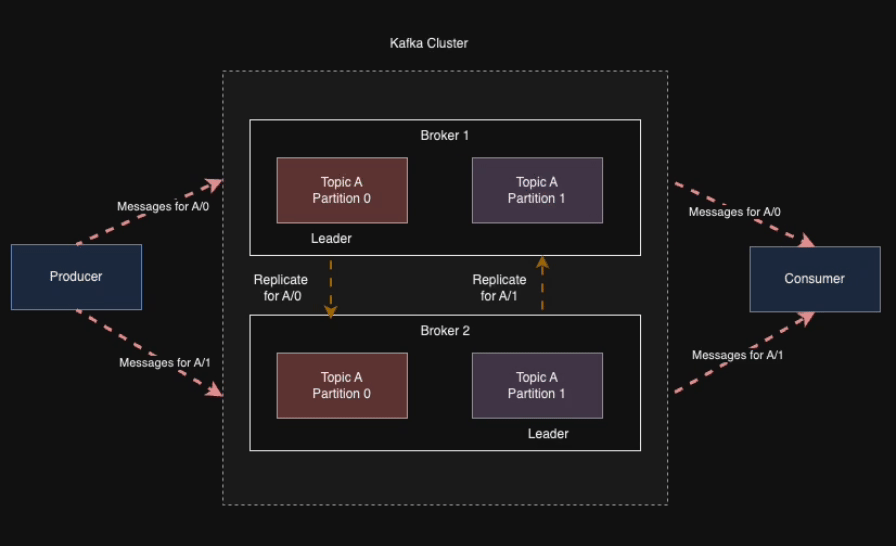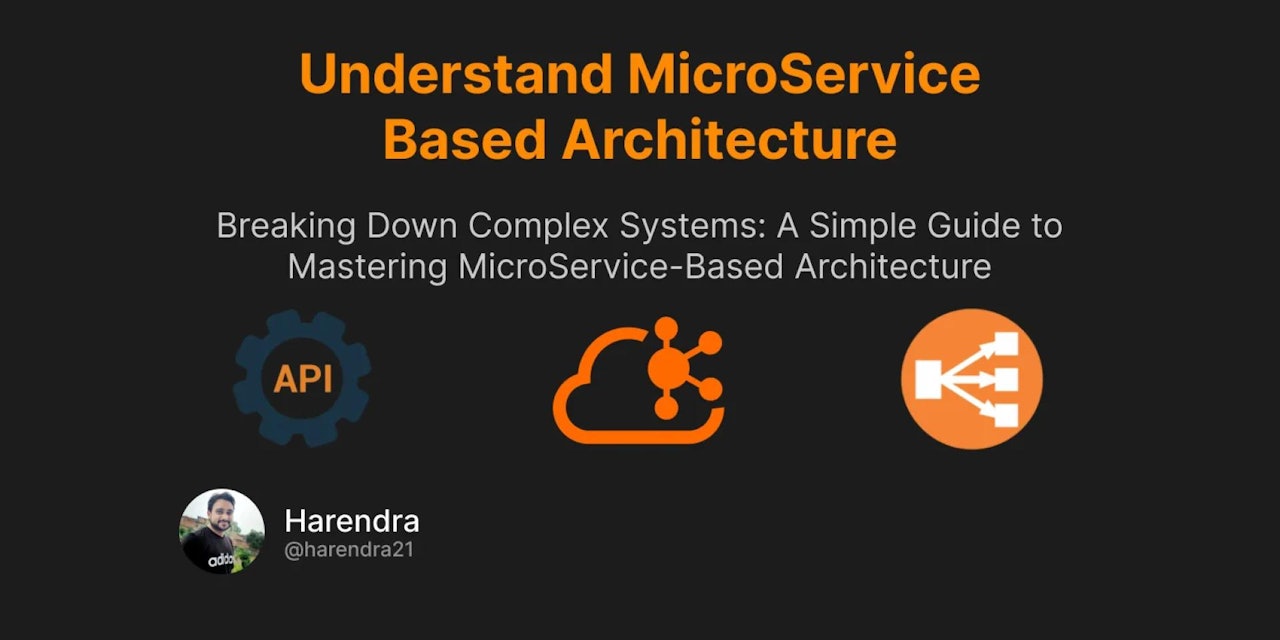Breaking Down Complex Systems: A Simple Guide to Mastering MicroService-Based Architecture
There are many types of software design patterns available, MicroService-based architecture is one of the most common architectures that is widely used by big giants such as Google, Netflix, Amazon, and Facebook. So basically you can say that we prefer to use the micro-service architecture to support large-scale systems due to its benefits, which we will see in a few minutes.
Understand MicroService-Based Architecture
Before beginning with this article I want to let you know about how many types of main software architecture are available, below is the list of them —
- Monolithic
- Microservices
- Serverless
- Event-Driven
- Layered (N-Tier)
- Service-Oriented Architecture (SOA)
- Component-Based
- Peer-to-Peer (P2P)
- Domain-Driven Design (DDD)
What are Microservices?
The microservice-based architecture is a design pattern in which we divide the larger services into smaller independent services and those services can communicate with each other with the help of well-defined APIs. Every service has its roles and responsibilities and it focuses only on that business function. Some characteristics of microservice include:
- Modularity: We are developing the services in independent modules that are easy to develop, maintain, reuse, and scale.
- Decentralization: This is another key characteristic of microservice Architecture, different services can use different technologies such as databases, programming languages, etc.
- Scalability: We can scale independent services based on the demand which is more useful to optimize the resources.
- Autonomy: We can develop, deploy, and run each service independently, which helps us to improve flexibility and resilience.
- Continuous Deployment: The independent running service is more flexible to update and maintain, which helps to achieve continuous integration and deployment.
Below is the diagram for MicroService-Based Architecture, let’s understand the each and every individual components of it.
MicroService Architecture
Static Files and CDN
Static files in websites are nothing but files like javascript (.js), CSS (.css), images (.jpg, .png, .webp, or .gif), and videos (.mp4). To store those files we are using the storage buckets and to serve them we are using CDN (content delivery network) which is another type of networking system that delivers the files from the nearest server.
 View Website
View Website
 View Website
View Website
 View Website
View Website
Load Balancer
A load balancer is a device or software that is used to distribute the incoming traffic across the services to prevent the primary server from getting overloaded. Some main features of load balancer are as follows-
- Traffic Distribution: It helps to distribute the incoming requests across multiple servers to prevent the single server from becoming a bottleneck
- High Availability: It also helps the application to keep working in server failure by redirecting the traffic to a healthy one.
- Scalability: Load balancer allows to addition of more servers and distribution of the load across them at the time surge (high requests)
- Performance Optimization: It improves the performance by reducing the latency of the requests and making them more available.
API Gateway
The API Gateway is a server that acts as an entry point for any API request and it helps to manage and route the request to the appropriate backend service in an application. It captures incoming requests and routes them to the appropriate backend service. The key features of API gateway include -
- Request Routing: It redirects the API request to the appropriate microservice based on its URL or params (query params or route params).
- Load Balancing: It also distributes the requests to multiple instances of micro-service to keep the load evenly distributed and ensure high availability.
- Authentication and Authorization: The load balancer also acts as the route guard for the API requests by validating the credentials and permissions before providing them access.
- Rate Limiting: Api gateway can prevent the number of requests based on the IP or other configuration to prevent overuse or attack.
- Aggregation: The response from different micro-services can also be combined into one single response.
Identity Provider
An Identity Provider is a service used to manage and authenticate user identities. It provides a centralized system to authenticate the user’s access and various micro-services. The key features of Identity Provider include -
- Authentication: Authentication is a process that verifies the authenticity of a user’s identity to access the feature.
- Single Sign-On (SSO): SSO is the process of authentication that allows users to authenticate using a single identity at many places.
- User Management: This refers to the management of users based on their roles, restricting or allowing them to use a particular resource.
Message Broker
It is a middleware between different services that is used to communicate internally to exchange data. It acts as an intermediary that receives, stores, and sends them from consumer to producer.

Kafka (Message Broker)
Key functions include:
- Message Routing: It is a key requirement for system and service integration. One pattern that can be used to separate a message source from its destination is message routing.
- Message Queuing: A message queue is a form of asynchronous service-to-service communication used in serverless and microservices architectures.
- Message Transformation: In microservices, message transformation refers to transforming messages that are sent back and forth between services into a format that is understandable to each service.
Service Registry and Discovery
Services can locate and communicate with each other dynamically thanks to service registry and discovery. Service Discovery allows services to find and connect based on the information supplied by the registry, guaranteeing scalability and resilience in the system. The Service Registry maintains track of all available service instances and their locations.
There are two types of Service Discovery available
- Client-Side Service Discovery
- Server-Side Service Discovery
Service Coordination (Zookeeper)
ZooKeeper is a distributed, open-source coordination service for distributed applications. It exposes a simple set of primitives that distributed applications can build upon to implement higher level services for synchronization, configuration maintenance, and groups and naming. It is designed to be easy to program to, and uses a data model styled after the familiar directory tree structure of file systems. It runs in Java and has bindings for both Java and C.[source]

Database
An organized set of electronically recorded data is called a database. Any kind of data, including text, numbers, pictures, videos, and files, can be included. Data may be stored, retrieved, and edited using software known as a database management system (DBMS).
Pro/Cons
Pros of Microservices:
- Scalability: We can scale up and down the services independently based on their usages or demand
- Flexibility: Microservice allows to use the of multiple technologies together such as multiple programming languages as per their advantages such as Python, golang, or Java.
- Resilience: As the services are running individually they are affecting less during the outage, and your entire system will not crash.
Cons of Microservices:
- Complexity: As we need to develop and run the services individually, it increases the codebase and complexity of the overall system which is a little bit hard to manage.
- Communication Overhead: In microservice, we have to establish the communication between the service to exchange information which is a little bit overhead here.
- Data Consistency: Maintaining consistency across distributed services can be challenging, as each service may have its own database and data model.
Thank you for reading this blog post, if you are interested in learning more about golang or full-stack development, consider following me. I keep writing posts about it regularly.
- Medium — https://medium.com/@harendra21
- Twitter (X) — https://x.com/harendraverma2


Comments (0)